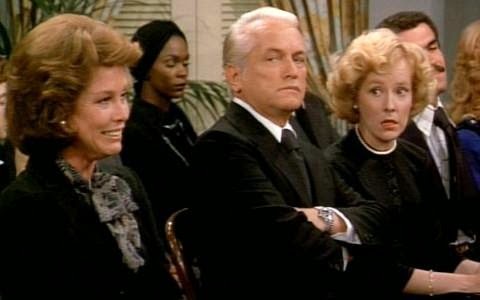There is no pre-set formula
for achieving classic TV status. But when a series stays on the air for 10
years, earns praise for the quality of its writing and ensemble cast, wins
numerous Emmy Awards, and impacts the popular culture in a way that merits
reference in nightly news broadcasts, that series almost inevitably qualifies
as something special.
So why has Murphy Brown, which did all of these things, not endured like,
say, The Mary Tyler Moore Show,
a series with very similar DNA?
I used to watch Murphy
Brown every week. I looked forward
to the recurring bits and gags, from Murphy’s love of (badly) singing classic
Motown to her never-ending quest for a competent secretary. I enjoyed the
visits from her mother, played by the wonderful Colleen Dewhurst, and the way
the series blended fiction and reality by casting several prominent television
journalists (Connie Chung, Linda Ellerbee, Joan Lunden) as Murphy’s
antagonistic colleagues.
I remember the milestone
episodes, such as when Murphy gave birth to her son, an event that generated
headlines when Vice-President Dan Quayle questioned the wisdom of glorifying
single-parent households. This inspired a brilliant episode in which Quayle’s
comments were incorporated into the story, along with a few shots at the
politician’s inability to spell “potato.”
This was a show that seemed
at home in the classic TV universe, never more so than when Marcia Wallace
reprised her role as Carol Kester from The Bob Newhart Show. Finally, Murphy had capable help, at least until
Bob Hartley (Newhart) arrived to entice her back to Chicago.
And yet, I have no desire
to revisit these episodes. And I’m apparently not alone; the first season was
released on DVD in 2005, but sales were so low that subsequent seasons are
still not available.
Why is that critical
“re-watchability” factor that defines the Comfort TV era missing from this once
popular and esteemed series? After pondering this question for a while I’ve
come up with three possible answers.
1. It Came Along Too
Late
The original run of Murphy
Brown (1988-1998) emerged at a time
when viewers were no longer embracing sitcoms the way they had in previous
decades. While many of the series’ characters had real-world counterparts that
were immediately recognizable, the Murphy Brown dramatis personae never became archetypes. Today’s cable news
channels have no shortage of attractive blonde females, some with dubious
journalism credentials, yet no one would ever refer to one of them as a Corky
Sherwood (played on the series by Faith Ford). Despite 10 years and nearly 250
episodes, the characters introduced by the series never penetrated the pop culture
as deeply as Ted Baxter or Lou Grant.
2. It Was On Too Long
Speaking of which – even
the diehard Murphy Brown fans
out there would concede that the show lost its mojo somewhere around season 5
or 6. Series creator Diane English left, as did reliable supporting players Pat
Corley and Grant Shaud. The addition of Lily Tomlin probably seemed like an
inspiration but it weakened the chemistry of the newsroom scenes. The final
season presented a story arc in which Murphy was diagnosed with breast cancer.
Several sources report that these episodes triggered an increase in mammograms,
so it’s hard to disparage shows that may have actually saved some lives. But
would you want to watch them again?
3. It Was Too Current
Name-dropping was a rich
source of humor on Murphy Brown.
But how many people today would laugh at a Strom Thurmond joke? Combine that
dated quality with a stridency of one-sided political opinion, and the result
is a series that may have played well in its day but now offers the same
experience as reading an old newspaper. Contrast this with The Mary Tyler
Moore Show, a newsroom-centric show
that aired 20 years before Murphy Brown but resisted taking strong positions on the issues of the day. Back
then, the first rule of situation comedy was to entertain, not proselytize; why
alienate half of your audience?
Another 15 years have
passed since Murphy Brown left
the air, and television has since become even more hostile and more divisive.
That inspires many of us to return to the Comfort TV of past generations. But
where some shows age like fine wine, others sadly spoil like whole milk.
Murphy Brown deserved its praise and its Emmys. I’m glad Candace
Bergen finally found a place to stretch her comedy skills after hosting several
memorable Saturday Night Live
episodes in the ‘70s. But if it’s all the same, I think I’d rather watch
Chuckles bite the dust one more time.













